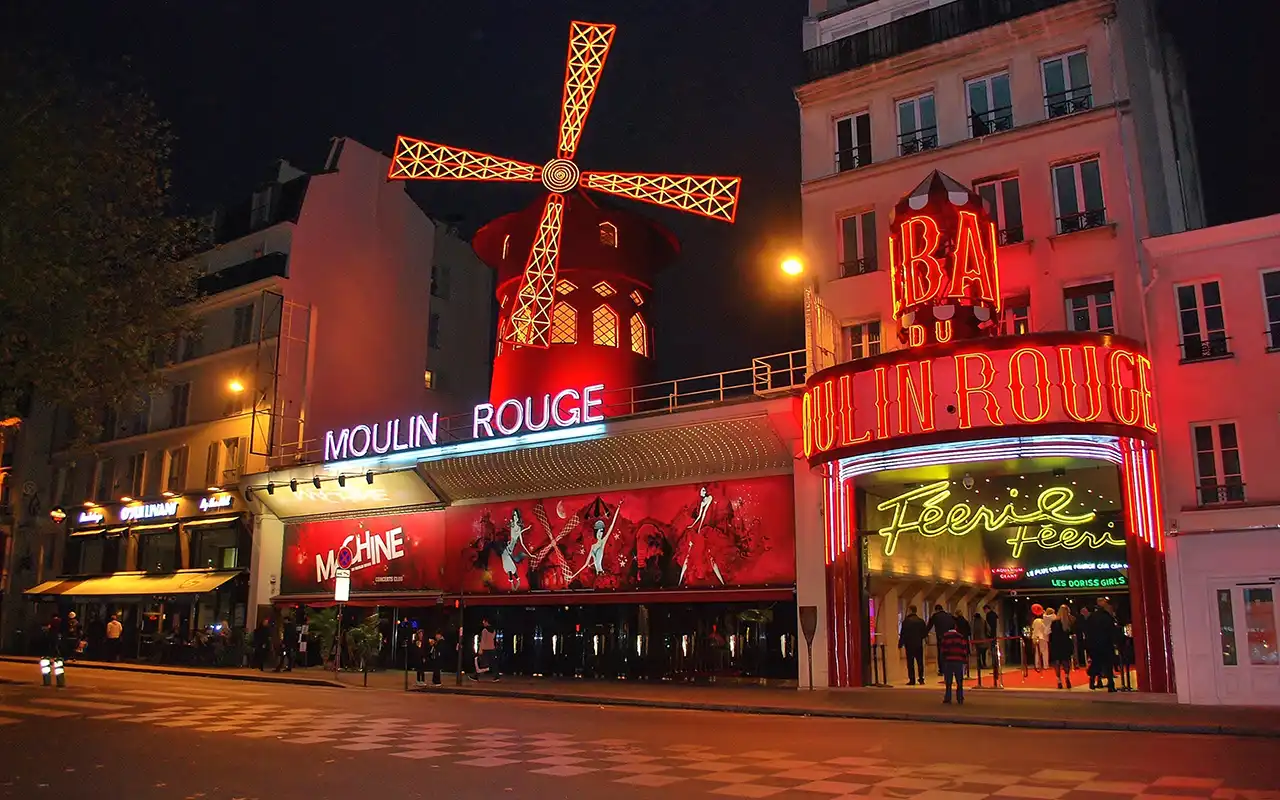
Navigating Moulin Rouge : Answers to common questions
- Admission Fee: Prices start at 88 € per person
- Hours of Operation: Opens at 6:45 pm. Dinner with show at 7pm. 1st show starts 9:00 pm. 2nd show starts 11:00 pm.
- Handicap Accessible: Disabled Access
- Photography: For copyright and security reasons it is strictly forbidden to photograph, film or record all or part of the Moulin Rouge theatre and the show.
- Family Friendly: Children are accepted from age six (6) and must be accompanied by an adult. Please note, however, that the “Féérie” show includes passages with nudity
- Restaurant or Cafe: Optional dinner available with show.
Please note all times and prices subject to change. Please check the offical website for details.
The Moulin Rouge, translated as "Red Mill," is a world-famous cabaret in Paris known for its iconic windmill and vibrant performances. Nestled in the heart of the picturesque Montmartre district, the Moulin Rouge has been a cultural and entertainment icon since its opening in 1889.
The creation of Charles Zidler and Joseph Oller, the Moulin Rouge was designed to be a space for entertainment, dance, and music that could be enjoyed by people from all walks of life. It has since become synonymous with the bohemian spirit and libertine atmosphere of Paris during La Belle Époque. This article delves into the history, evolution, and significance of this iconic Parisian establishment.
A Look into the Past: La Belle Époque and the Birth of Moulin Rouge
In the late 19th century, a period of rapid artistic and cultural development swept across Europe, a time now referred to as La Belle Époque (1871-1914). This era saw the birth of various artistic movements such as Art Nouveau, cinema, and music. During this time, Paris was a hive of creative activity, and entertainment establishments began cropping up in the city. Montmartre, once a quiet village on the outskirts of Paris, became a bustling hub of bohemian and artistic life that attracted people from all walks of life.
The opening of the Moulin Rouge on October 6, 1889, by Charles Zidler and Joseph Oller, coincided with the 1889 Exposition Universelle, a world's fair that showcased the cultural, social, and economic progress of France. The two entrepreneurs aimed to create a space that catered to both the upper and lower classes, offering an escape from reality where patrons could enjoy the pleasures of dance, music, and risqué entertainment. Thus, the Moulin Rouge was born.
Entertainment and Performances at Moulin Rouge
The Moulin Rouge has evolved significantly since its opening, with a constant flow of new acts, shows, and artists gracing its stage. Some of the most iconic performances that have occurred within its walls include the French cancan, a high-energy and provocative dance that originated in the 1840s. The French Cancan became synonymous with the Moulin Rouge as dancers like La Goulue and Jane Avril became famous for their spectacular performances.
Over time, the Moulin Rouge has hosted performances by legends such as Edith Piaf, Josephine Baker, Yves Montand, and Charles Aznavour. The venue has consistently adapted its performances to remain relevant to contemporary audiences while maintaining the charm and spirit of its origins. In 1999, the Moulin Rouge celebrated its 110th anniversary with the launch of the show "Féerie," a spectacular display of dance, acrobatics, and music that has wowed audiences ever since.
Moulin Rouge and Art
Beyond the stage, the Moulin Rouge has been immortalized by various artists who have drawn inspiration from its lively performances and bohemian atmosphere. Perhaps the most famous depiction of the Moulin Rouge is Henri de Toulouse-Lautrec's painting "La Goulue at the Moulin Rouge." Toulouse-Lautrec, a regular at the establishment, captured the frivolous spirit and sensuality of the cabaret, portraying famous performers like La Goulue and Jane Avril.
Throughout the years, the influence of the Moulin Rouge has extended to film and literature, from Jean Renoir's classic film "French Cancan" (1954) to more recent international sensations like Baz Luhrmann's "Moulin Rouge!" (2001). These representations have fueled a certain mystique surrounding the establishment, consolidating its status as a legendary symbol of Parisian culture.
The Enduring Spirit of the Moulin Rouge
Over the years, the Moulin Rouge has endured numerous challenges, including two fires, a World War, and changing social attitudes. However, its spirit remains undeterred, and it has consistently adapted to the times to remain a relevant and thriving institution in Parisian culture.
The significance of the Moulin Rouge lies in its unwavering commitment to providing a space for creative expression and entertainment while remaining true to its roots. It continues to attract audiences from around the world, all searching for a glimpse of the Parisian glamour and bohemian spirit that once defined La Belle Époque.
Moulin Rouge Today
Today, the Moulin Rouge remains a must-see attraction for many visitors to Paris. The current show, "Féerie," features over 80 artists, including 60 Doriss Girls dressed in stunning costumes adorned with feathers, rhinestones, and sequins. Set against the backdrop of impressive sets and accompanied by enchanting music, the performances transport audiences to a world of fantasy and extravaganza, where talented dancers, acrobats, and performers showcase their exceptional skill and artistry.
Visitors can also indulge in a pre-show meal at the Le Moulin Rouge restaurant "La Machine," which offers a sophisticated menu inspired by the culinary delights of France. Here, patrons can immerse themselves in an elegant-dining atmosphere complemented by live music before embarking on their Moulin Rouge adventure.
Since its inception in 1889, the Moulin Rouge has been a symbol of Parisian entertainment and culture, embodying the spirit of La Belle Époque by providing a space for artistic expression, innovation, and creativity. Today, its iconic windmill, lush velvet, and sparkling lights continue to beckon visitors from around the world, offering a sense of timelessness and escape that few places can rival. A visit to the Moulin Rouge is an unforgettable sensory experience – an ode to the vibrant spirit of Paris.
More in our list of Things To Do In Paris
;Palais-Royal Current Weather
Local Temp: 13.4℃ / 56.1℉
High: 14.6℃ / 58.3℉
Low: 11.1℃ / 52℉
Humidity: 83 %
Local Time: 09:29
Map for Moulin Rouge
Did You Know?
The name "Moulin Rouge" translates to "Red Mill" in English, named after the red windmill on its roof, which has become an iconic symbol of Parisian nightlife. The cabaret initially introduced the can-can dance to the public, a high-energy and physically demanding dance that became synonymous with the Moulin Rouge and contributed to its reputation as a place of exuberant entertainment.
The Moulin Rouge is not just a tourist attraction but a working entertainment venue that continues to offer a variety of performances, including dinner shows that combine gourmet French cuisine with spectacular dance routines featuring the famous Doriss Girls. The shows are known for their elaborate costumes, featuring feathers, rhinestones, and sequins, designed to dazzle audiences.
Throughout its history, the Moulin Rouge has been a popular venue for many famous artists and performers, including Édith Piaf, Josephine Baker, Frank Sinatra, and Liza Minnelli. The venue has also inspired numerous works of art, literature, and film, most notably the 2001 movie "Moulin Rouge!" directed by Baz Luhrmann, which reimagined the cabaret's golden age with a modern soundtrack and vivid cinematography.
Over the years, the Moulin Rouge has adapted to changing tastes and times while retaining its essence as a cabaret. It remains a testament to Paris's enduring allure as a city of art, culture, and nightlife. Visiting the Moulin Rouge offers a glimpse into the city's hedonistic past and the chance to experience one of the last vestiges of a bygone era of glamour and extravagance.
The Moulin Rouge, located in the Pigalle neighborhood near Montmartre in Paris, is one of the most famous cabarets in the world. Opened on October 6, 1889, by Joseph Oller and Charles Zidler, it quickly became a symbol of the Belle Époque era, known for its lavish shows, extravagant costumes, and the celebration of freedom and pleasure.
Travel Information for
Paris Visitors
Time Zone: Paris operates on Central European Time (CET), which is 1 hour ahead of Greenwich Mean Time (GMT+1).
Weather: Paris has a Western European oceanic climate. The summers are generally warm and pleasant with average temperatures between 15 to 25 degrees Celsius (59 to 77 degrees Fahrenheit). Winters are cold with temperatures often dropping to around 1 to 7 degrees Celsius (34 to 45 degrees Fahrenheit). Rain is fairly distributed throughout the year, with light showers more common.
Population: Paris has a population of over 2 million people within its administrative city limits. The wider Paris metropolitan area has a population of around 12 million, making it one of the largest urban areas in Europe.
Size: Paris covers an area of about 105 square kilometers (40.7 square miles). Despite its relatively small size, the city is densely populated and is divided into 20 districts, known as arrondissements.
Language: The official language is French. While many Parisians speak English, especially in tourist areas, learning a few basic French phrases can be helpful and is appreciated by the locals.
Currency: France uses the Euro (€). Credit cards are widely accepted, but it's always a good idea to have some cash, especially for smaller purchases in bakeries, open markets, or in areas less frequented by tourists.
Safety: Paris is generally considered safe for tourists. Like any major city, it's advisable to be aware of your surroundings and take standard safety precautions, especially in crowded areas and on public transportation.
Tipping: In Paris, a service charge is usually included in the bill at restaurants. However, it's customary to leave a small extra tip if you're happy with the service.
Electricity and Plugs: France uses Type C and Type E plugs, and the standard voltage is 230 V with a standard frequency of 50 Hz. Travelers from countries with different electrical standards may need adapters.
Water: Tap water in Paris is safe to drink. Many cafes and restaurants will serve tap water for free if requested.
Verified & Trusted Contact Information for Moulin Rouge
Contact: Official Site
Address:
82, boulevard de Clichy 75018 Paris
Website: www.moulinrouge.fr/en/homepage/
Latitude: 48.8841
Longitude: 2.3323






















